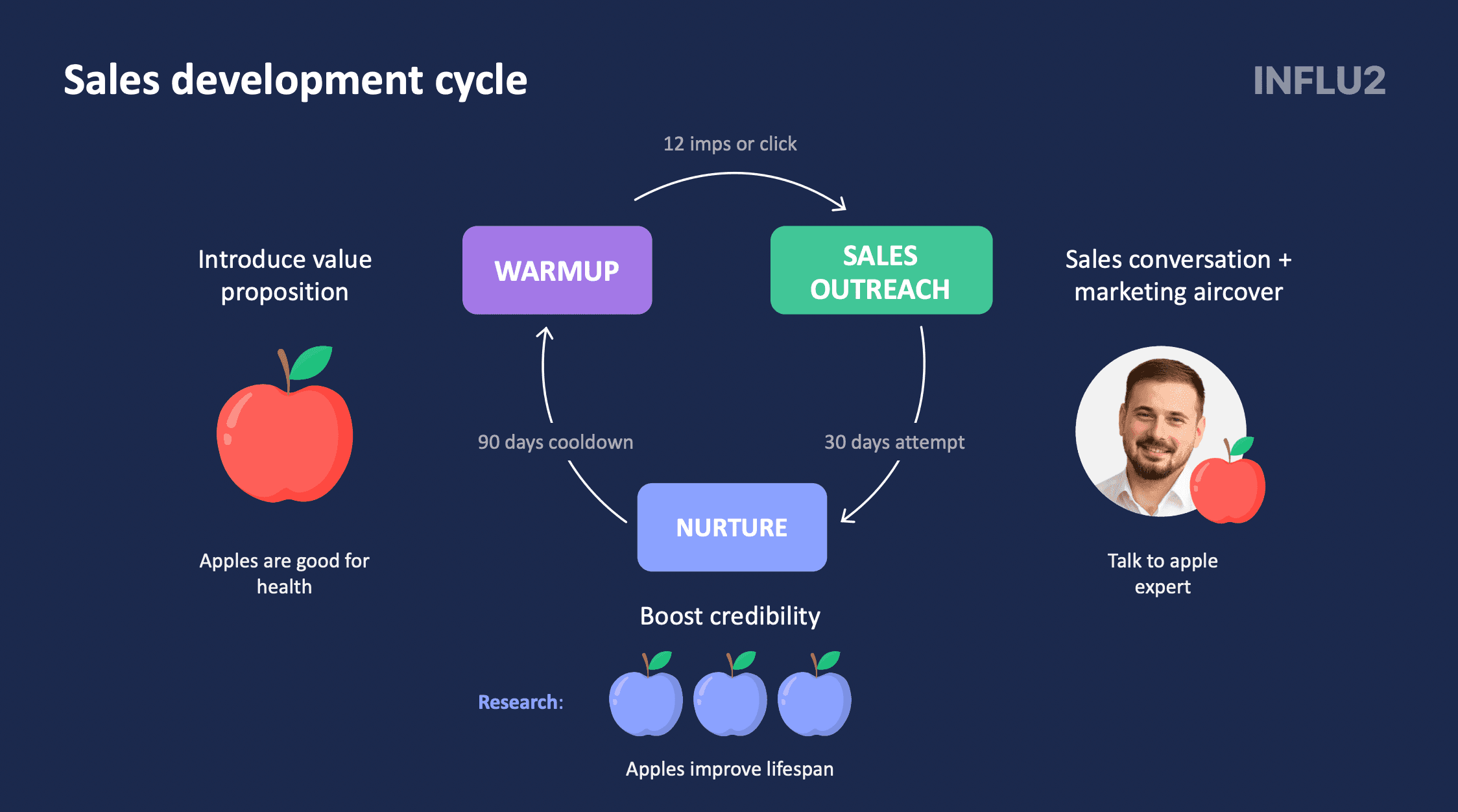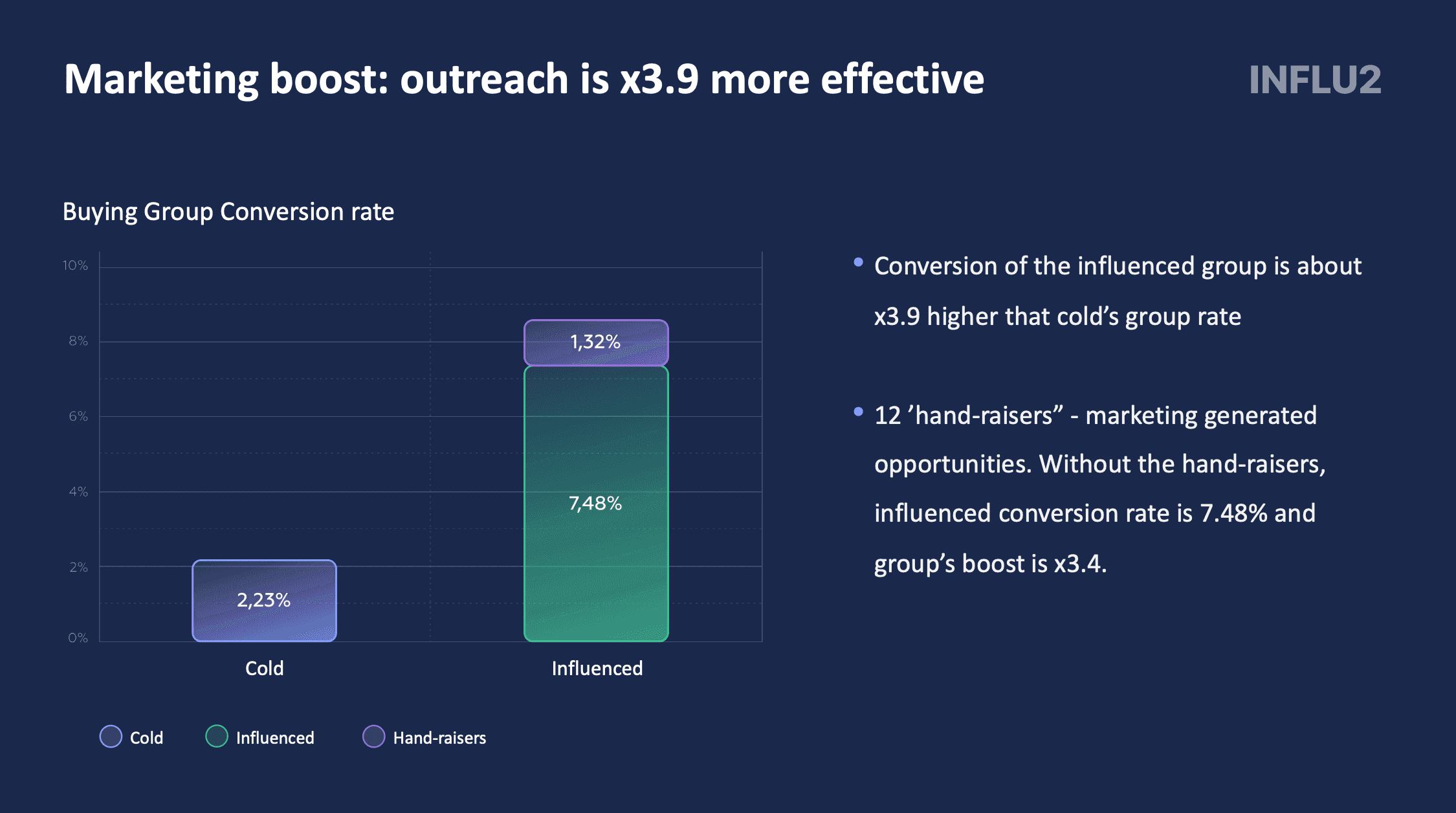Aligning on the Vision of Buying Group Opportunities With Forrester and Influ2

The size of buying committees continues to increase, with 66% of B2B buying teams now consisting of more than six people. As buying teams become more prominent, organizations need to shift to a more meaningful, aligned strategy to successfully target this audience successfully.
To weather the upcoming economic storm and create experiences that resonate with today’s B2B buyers, organizations have to move away from thinking about prospects as individual leads. You’re selling to groups of buyers, who each have their own pain points and may be a great fit for one of your products or services, but not others.
Influ2’s Dmitri Lisitski and Forrester’s Malachi Threadgill recently presented a webinar on the importance of going beyond sales and marketing alignment to deliver a truly excellent customer experience. They discussed how to restructure internal teams, redefine success, and spark a new culture centered around buying group obsession, not leads and arbitrary funnel metrics.
Change the focus from leads to buying groups
Prioritize the buying group experience over dredging up individual leads at the top of your funnel in alignment with programs and technology.
“While nearly 80% of B2B buyers make decisions with a group or team, only 30% say that they’re good at persuading others about that vision,” Threadgill said during the webinar. Even though B2B buyers are making decisions as a group, they’re not very confident in their ability to convince their peers to go in a particular direction.
It’s on your organization to leverage your tools and a deep understanding of your personas to strategically send messages that resonate throughout the buying group in order to influence them collectively. Otherwise, your teams will persuade one prospect, but another group member won’t be so convinced.
“We have to present to those buying group members the pain points that resonate with them in particular,” Threadgill said.
Build out marketing and sales programs that account for the needs of the full buying committee, with materials and messaging that support each of them on their journey. While individual needs have to be addressed, they’re all moving together throughout the process to make a decision.
Change the work to create buying group experiences
Manage the change so the work results in impactful buying group experiences.
- You have three areas or levers to control through execution:
- Insights and data
- Collaboration between sales and marketing
- Customization in your campaigns
You can push and pull on each lever to determine how much investment to put into your target accounts and opportunities, depending on their market fit and sales readiness. Instead of just filling your funnel with as many leads as possible, you want to take a more strategic approach about who and how to target accounts.
Essentially, Threadgill says, you take your traditional buyer’s journey map and make it three-dimensional. You’re now accounting for five individuals in a buying group to nurture and convert, as opposed to just one on a solo journey.
“We really need to start moving away from that one person,” Threadgill said. “I’m not going to go all the way and say the lead is dead because the lead is not dead, but there’s some concern about that MQL. Would you rather have an MQL who scores 100, that arbitrary value, or four engaged individuals?”
You might collect intent data that shows four prospects within an account who are in-market, each with lead scores of 30. Combined, their lead score across the account is 120. You can then test their engagement with your campaigns and sales reps, and see how it compares to that one MQL with a score of 100. If you only pay attention to individual lead scores, you’ll miss important engagement signals across highly qualified accounts.
Change the culture to spark buying group obsession
Create buying-group obsession among your sales and marketing teams to design more effective customer journeys and drive revenue growth.
“41% of companies with mature, customer-obsessed cultures achieve 10% revenue growth in their last fiscal year compared to just 10% of less mature companies,” Threadgill said.
In today’s B2B world, “customer-obsessed” means being obsessed with engaging and delighting your core buying groups. Those are the people who are coming together to make decisions about tools and infrastructure for their companies.
Here are some red flags to look out for if your culture requires a spark:
- The mindset and strategy still centers around sourcing as many leads as possible
- There’s a split between sales and marketing, where marketing is focused on leads and sales is focused on opportunities
- Lead goal achievement is the main predictor of revenue goal achievement
A healthy, buying-group-obsessed culture looks like this:
- Marketing and sales are aligned on the buying group needs for each opportunity
- The buying group experience becomes the main predictor of revenue goal achievement
- You’re measuring buying group efficacy by measuring win rates of groups nurtured by marketing vs. sales-created opportunities
Siemens took some of these steps to instill a customer-focused culture among their 1,500 marketers. They embraced the Buying Group Marketing mindset over lead capture. One of the most notable actions they took was removing the lead object from all of their processes.
“Making the switch to buying groups intellectually makes sense, but we have been in a lead world for so long, it’s literally 2% process and technology and 98% a rewiring of the cultural mindset,” said Lance Murphy, VP of Demand Creation at Siemens.
Account for nurturing in the sales development cycle
Coordination between marketing and sales is critical during the sales development cycle to give prospects the best possible experience. To ensure you’re delivering on buying group needs, continue to nurture prospects along after the initial sales outreach — even if they don’t convert.
Even though you’re engaging with a buying group, you want sales reps to step in right away when individuals are ready after marketing has a successful engagement so they don’t go cold. Sales can leverage the information that marketing has gathered about the prospect and use that to start working the account, according to Lisitski.
Importantly, you’re never going to see 100% conversion rates on the first outreach from sales. They’ll probably be closer to 10%, and you can count that as a success. So apply a strategy to keep nurturing those prospects and eventually turn them into opportunities for sales. Sales and marketing have to work together to build long-term relationships with high-fit prospects.

With this type of sales development cycle, there’s no handoff moment. Both sales and marketing share an ongoing flow of information. They use it to personalize the experience based on the customer and the CRM and intent data they’ve gathered.
Ditch MQLs for metrics that show marketing’s value to the sales pipeline
When two teams are so heavily involved in the sales process, how can you tell who’s responsible for building more pipeline — or where efforts need to improve? Use metrics that give you a real understanding of marketing’s contributions to growth and retention.
“The first version of the [revenue] waterfall came out in 2005, and that introduced the idea of the MQL,” Threadgill explained. “The first version of the iPhone wasn’t announced until January 2006. This arbitrary metric that we’ve been using for so long is older than the very first iPhone.”
Teams need to shift away from the outdated MQL as an indicator of marketing success and instead think about how marketing actually impacts the entire pipeline. It’s essential to consider opportunities within the target buying group.
“Focus on opportunities because influenced opportunities and influenced sales pipeline is what you look for when you try to understand marketing’s contribution to the sales effort,” Lisitski said.
Another important metric is marketing boosts toward sales goals. Rather than just determining marketing’s influence on pipeline, measure the performance of campaigns and targets with marketing input compared to those without any marketing input.
For example, Lisitski explained that after reaching out to some of their buying groups with nothing but cold outreach, those groups had a 2.2% conversion rate into sales opportunities. But another set of buying groups engaged with marketing before or during outreach. Their conversion rate rose to over 8%.

Track sales and marketing alignment in real-time with Influ2
Gain visibility into how your sales and marketing teams are working collaboratively to warm up and reach out to prospects with real-time, reliable metrics. You’ll better understand gaps and adjust your buying group strategy to create a more influential journey for customers. Influ2’s tracking breaks down engagement at the warmup, sales outreach, and nurture stages, so you have complete visibility into what’s working at each step.
Schedule a demo with Influ2 to take a closer look at our dashboards and see how you can benefit from real-time engagement monitoring.

A proud marketing generalist driven by a strong urge to Always Be Learning (ABL). Nirosha has a career across many marketing disciplines and industries spanning close to 15-years. Now she is taking on the challenge to build out the evolution of Account-Based Marketing to Buying Group Marketing.



